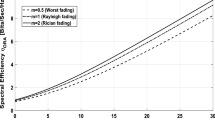Abstract
A single-input multiple-output (SIMO) system with lognormal multipath fading (LMF) channel is considered in this paper. The spectrum efficiency (capacity per unit bandwidth) of a LMF channel for various adaptation policies is studied. We obtain the closed-form expressions for various adaptation policies such as (i) optimal power and rate adaptation (OPRA) policy, (ii) channel inversion with fixed rate (CIFR) policy, and (iii) truncated channel inversion with fixed rate (TIFR) policy with hybrid diversity combining techniques like hybrid maximal ratio combining (MRC)-equal gain combining (EGC), hybrid EGC-MRC, and hybrid MRC-selection combining (SC) diversity. Numerical results show that the use of hybrid diversity combining techniques improves the spectrum efficiency over stand-alone diversity combining techniques. OPRA policy that provides the highest spectrum efficiency when compared to other policies is also shown.






Similar content being viewed by others
References
Stuber GL (1996) Principles of mobile communications. Kluwer, Norwell
Rappaport TS (2002) Wireless communications: principles and practice, secondth edn. Prentice Hall Inc., Englewood Cliffs
Goldsmith A, Varaiya P (1997) Capacity of fading channels with channel side information. IEEE Trans Inf Theory 43(6):1986–1992
Alouini M, Goldsmith A (1999) Capacity of Rayleigh fading channels under different adaptive transmission and diversity combining techniques. IEEE Trans Veh Technol 48(4):1165–1181
Park M, Chae C, Heath R Jr (2007) Ergodic capacity of spatial multiplexing MIMO systems with ZF receivers for lognormal shadowing and Rayleigh fading channels. Proceedings of the IEEE International Symposium on Personal, Indoor and Mobile Radio Communications (PIMRC), Athens, pp 1–5
Mokhtar M, Gupta S (1992) “Capacity of cellular CDMA PCS in Nakagami fading lognormal shadowing channels”. Proceedings of 1st International Conference on Universal Personal Communications, Dallas, pp 1–5
Tjhung T, Chai C, Dong X (1997) Outage probability for lognormal-shadowed Rician channels. IEEE Trans Veh Technol 46(2):400–407
Alouini M, Simon M (2002) Dual diversity over lognormal fading channels. IEEE Trans Commun 50(12):1946–1959
Steudi P, Alonso G (2007) “Lognormal shadowing meets SINR: a numerical study of capacity in wireless networks”. Proceedings of the 4th Annual IEEE Communications society Conference on Sensor Mesh and Ad hoc Communications and Networks (SECON), San Diego, pp 550–559
Ho M, Stuber G (1995) Capacity and power control for CDMA microcells. J Wirel Netw 1(3):355–363
Prasad R, Kegel A (1993) Effects of Rician faded and lognormal shadowed signals on spectrum efficiency in microcellular radio. IEEE Trans Veh Technol 42(3):274–281
Bhaskar V (2007) Spectrum efficiency evaluation for MRC diversity schemes under different adaptation policies over generalized Rayleigh fading channels, Int J Wireless Inf Networks 14(3):191–203
Bhaskar V (2007) Spectrum efficiency evaluation for MRC diversity schemes under different adaptation policies over generalized Rician fading channels. Int J Wireless Inf Networks 14(3):209–223
Laourine A, Stephenne A, Affies S (2007) Capacity of lognormal fading channels. Proceedings of the International Conference on Wireless Communications and Mobile Computing, Honolulu, pp 13–17
Shen D, Lu A, Cui Y, Kuang F, Zhang X, Wu K, Yao J (2010) “On the channel capacity of MIMO Rayleigh-lognormal fading channel”. International Conference on Microwave and Millimeter Wave Technology (ICMMT), Chengdu, pp 156–159
Hsiung K (2007) Stochastic power allocation with outage-expectation constraints in lognormal fading wireless channels. Canadian Conference on Electrical and Computer Engineering, Vancouver, pp 1547–1548
Cotton SL, Scanlon WG (2007) “Higher-order statistics for lognormal small-scale fading in mobile radio channels,” IEEE Antenna and Wireless Propagation Letters, pp. 540–543
Rajendran VG, Bhaskar V (2012) Capacity analysis of LMF channels under different adaptation policies with and without diversity combining. International Conference on Advances in Computing, Communications and Informatics (ICACCI), Chennai, pp 678–682
Mohamed R, Ismail MH, Mourad HAM (2015) Average symbol error rate and ergodic capacity of switch-and-examine combining diversity receivers over the α−μ fading channel. Ann Telecommun 70:37–48
Panagopoulos AD, Chatzarakis GE (2007) Co-channel interference effects as applied to broadband fixed wireless access channel capacity statistical distribution. Ann Telecommun 62(9–10):955–966
Duman T, Ghrayeb A (2007) Coding for MIMO Communication systems. Wiley, England
Papoulis A, Unnikrishnan Pillai S (2002) Probability, random variables, and stochastic processes, McGraw Hill, 4th Edition
Jakes W (1994) Microwave mobile communications, secondth edn. IEEE Press, Piscataway
Gradshteyn I, Ryzhik I (1994) Table of integrals, series, and products, fifthth edn. Academic Press, San Diego
Author information
Authors and Affiliations
Corresponding author
Rights and permissions
About this article
Cite this article
Bhaskar, V., Rajendran, V.G. Spectrum efficiency evaluation of LMF channels under various adaptation policies with hybrid diversity schemes. Ann. Telecommun. 71, 15–26 (2016). https://doi.org/10.1007/s12243-015-0476-5
Received:
Accepted:
Published:
Issue Date:
DOI: https://doi.org/10.1007/s12243-015-0476-5




